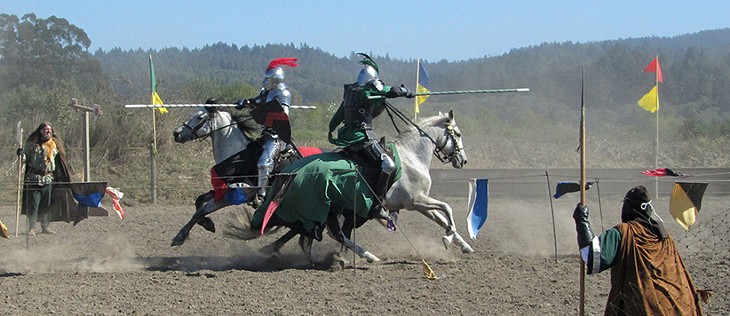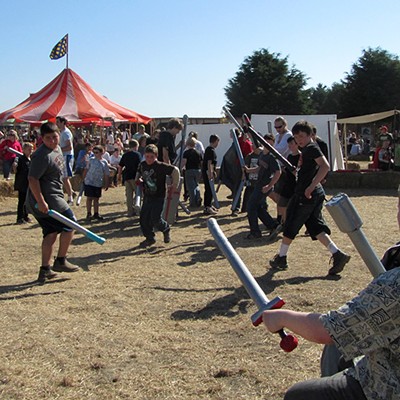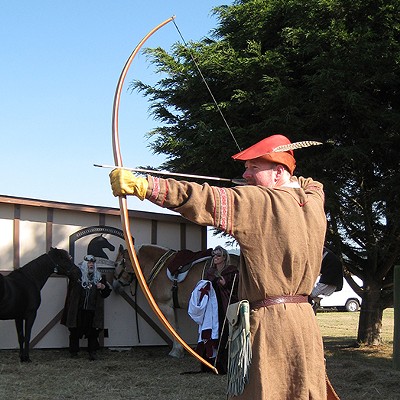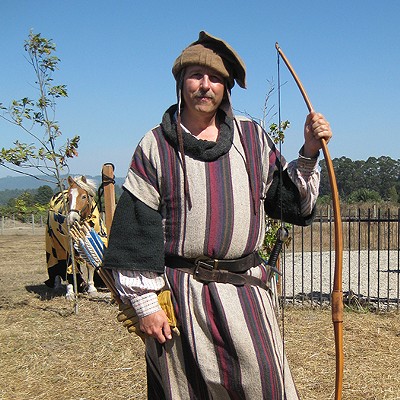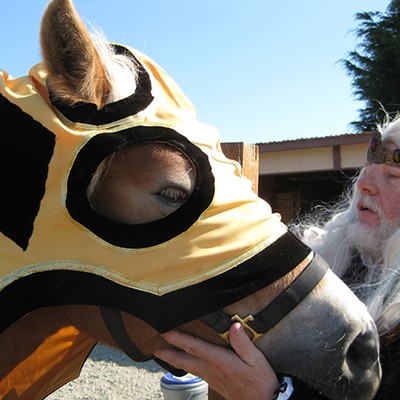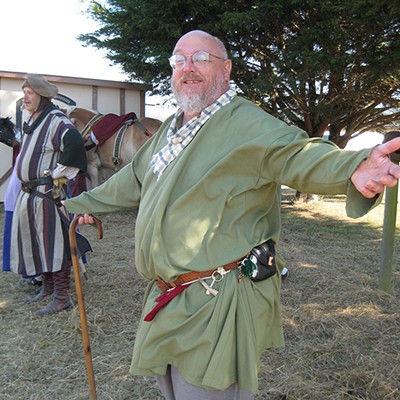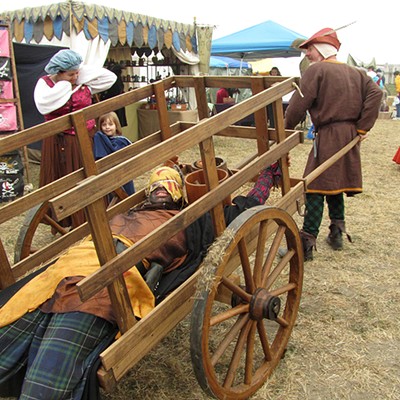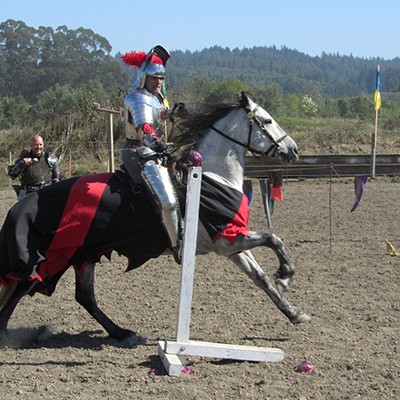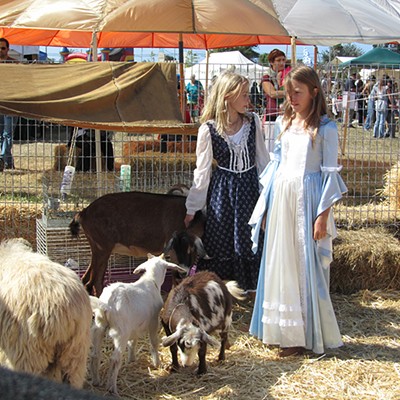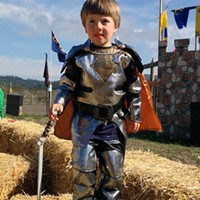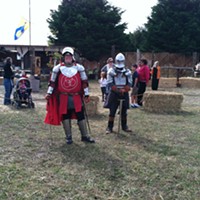Going Medieval
Escapism, community and a good time out of time
By Jennifer Fumiko Cahill [email protected] @jfumikocahill[
{
"name": "Top Stories Video Pair",
"insertPoint": "7",
"component": "17087298",
"parentWrapperClass": "fdn-ads-inline-content-block",
"requiredCountToDisplay": "1"
}
]
The field beside Mad River Community Hospital is empty, with only a painted sign for the Dark Horse Tavern on the stable. But in a few days, it'll be filled with tents and a tavern, populated by knights, knaves and a village of Vikings. Men and women will clash with swords and sticks, and jousters will, well, joust. Peasants and tradespeople will all be on hand to party like it's 999.
The Excalibur Medieval Tournament and Market Faire on Saturday and Sunday, Sept. 28 and 29, benefits St. Bernard's School, Mad River Adult Day Health Care and Redwood Horse Rescue. Unlike larger Renaissance fairs, it's run by volunteers, people who just love doing things the really old fashioned way. Hard on its heels a week later comes the Medieval Festival of Courage in Blue Lake, which is a fundraiser for Coastal Grove Charter School, as well as several other area schools and nonprofits.
Both are part of a 50-year-old movement that takes European history, throws on some tights and turns it into a party. Renaissance and medieval fairs and festivals have been around since 1963, when the first Renaissance Pleasure Fair in the Hollywood Hills raised cash for a local NPR station. These days, similar festivals (Renaissance, medieval, fairy, pirate) number in the hundreds across the country, including the two in Humboldt. Most visitors come to watch demonstrations and shows, take a few snapshots and pick up a souvenir. For others, the fairs are the high point of a year-round hobby of costumes and role-play. So how do grownups — smart ones — end up playing dress up?
According to Kimberly Tony Korol-Evans, author of Renaissance Festivals: Merrying the Past and Present, people get into the scene for very individual reasons. Some fall in love with the crafts, the clothes or the drama of the period. Plus, the fairs, festivals and societies also offer tremendous community. People who come together to share the experience for only a few days a year can be very close without even learning each other's real names.
The half a dozen costumed volunteers rehearsing at the Excalibur festival site earlier this month entered this world — part history, part fantasy — through love of history, pageantry, escapism and hamming it up. They chalk up the enduring interest in all things medieval and fantasy to Hollywood movies like The Lord of the Rings and Braveheart and shows like Game of Thrones. And maybe cleavage.
"Now it's cool, but we've been doing it for 30 years," says James Harvey II, his wooden cane planted like a sword. "Finally they catch up." Everyone chuckles. Harvey wears the label of nerd proudly (he's also proud husband of Journal Art Director Holly Harvey). The hobby is undeniably nerdy, with all the research, the obscure facts, the decidedly un-cool enthusiasm and the obsessive attention to detail. Even next to cosplay — people who dress up at comic conventions — this is far more academic. Here, among like-minded friends, they just don't giveth a rat's hindquarters.
King William, monarch of the Excalibur's imaginary kingdom, goes by Bill Kohse in the real world. Costume aside, it's easy to imagine his white beard and lined eyes in another time. But when he's sporting a jeweled crown and velvet robes, his slow, quiet way of talking comes across as regal reserve. Kohse is a retired Navy and Army man, and you can still find him in uniform now and then. Just not a modern one. For the past 40 years, he's been spending weekends as a Civil War soldier, an Old West gunslinger, a Redcoat, a Celtic priest and now a king.
Kohse didn't have to poison, imprison or battle anyone to become king. Game of Thrones it's not. Brushing aside the long, silver hair of his wig, he explains that he is simply filling a spot that was open. His bloodless ascent to the throne comes with no privileges, but Kohse, who has no grandchildren of his own, does enjoy the look on children's faces when he passes through the crowds at a festival. He calls it "magical."
When Kohse was in high school, he had a history teacher who sparked his imagination, and his time in the military stoked his interest in ancient battles and lost kingdoms. Kohse is still learning, and says that one of the benefits of the hobby is meeting people who are skilled experts in the arcane — people who have actually made coins or built boats by hand.
For history buffs, there is nothing like doing what you've only read about in books. "It's one thing to watch a Ken Burns documentary," says scholar Korol-Evans in a phone interview from her office in Washington, D.C. It's another to smell the powder from the musket." Wearing period clothing and testing out period tools can teach us about daily life in another time and show us where our assumptions might have been wrong.
A medieval dress, for example, is looser and comfier than you might imagine. And in colder weather (say, Wales 1,000 years ago), a girl might like a number of loose layers that allow for movement and a handy lace-up top for breastfeeding. When you're actually in them, the clothes reveal themselves as practical garments for their environment and purpose, instead of the clumsy inventions of people who hadn't yet figured out skinny jeans. Even a Renaissance corset — very different from Scarlet O'Hara's breath-inhibiting cincher — though awkward to get into, makes one feel a little armored.
John Jacques, another history buff, first visited a Renaissance fair with his high school choir. He was hooked instantly.
"Look at the cool stuff you get to wear," Jacques says, smiling.
Cool? Well, damn, maybe. Jacques is looking a little Robin Hood today, with his trim beard, the leather cap he made himself, the belt with hand-tooled Celtic knot-work and the 5 ½-foot wooden long bow. Only his diamond earring gives him away. Or maybe not — the Spaniards were pretty flashy back in the day. Jacques is far more particular about his clothes for events than for everyday. For him, the hobby is a chance to live out a fantasy — not necessarily a totally authentic re-creation (he'll skip the plagues, thanks) — and have a good time. It's also how he met his wife, Pia Gabriel, one of the festival organizers.
He takes aim at the target and is still a moment, like a painting of an archer. Once he's let the last arrow fly, he drops his arms and gives a little shrug to his friends, back to his modern self.
The handmade bow belongs to Tony Smithers, who found it in a junk shop and guesses its age at about 45 years. He draws his finger down the side of the bow and explains how the design matches the weapons used in the 12th to 14th centuries, with a layer of heartwood facing the archer and a layer of sapwood facing out to create a spring effect.
"They didn't know what they had. Don't tell anybody," he says with a grin. Each arrow's wooden shaft is tipped with a metal point meant for piercing armor — not Kevlar, mind you, the metal kind. And shooting them is not as easy as Orlando Bloom makes it look.
First you put on gloves, as there's no guard to spare your knuckle when the arrow passes over it. The arrow rests on that knuckle, which has to remain steady, like when you hold a cue stick. The arrow locks onto the bowstring with a notch in the wood, and you hold it in place with two fingers. Keeping your forward arm slightly bent (so as not to get snapped by what is essentially a giant sling shot) you pull back very hard all the way to your eye, aim and release those two string fingers. Some wooden long bows can deliver 120 pounds of force. Compound bows? Wench, please.
"We're united by the love of doing things the hard way," says Smithers. He and Jacques rib each other about their aim, but they're hitting the target pretty consistently. There'll be an archery contest at the festival, and the public is invited to join in, so long as one's bow is fairly old school.
This is just the sort of thing that sucks a person into re-enactment — you try a little archery, maybe spin a little wool, go a few rounds with a foam sword and before you know it, you're rocking head-to-toe velvet and blowing all your ducats in the Dark Horse Tavern.
Smithers, whose brow gathers into a soft furrow as he speaks, was always interested in fantasy literature. He even formed a Middle Earth U.N. in college with friends before eventually getting into historical re-creations. It's no surprise to him at all that he's still crafting arrows and dressing up in medieval clothing as a grown man with a job and a family. The costumes allow him to behave differently, "to be jolly and sing" and otherwise cut loose.
It's a relief, too, to free yourself from your smartphone for just a little while and enjoy simpler entertainment. The group marvels at how many visitors at last year's event were pulled in by the low-tech games and the always popular "hunker hauser," in which contestants try to pull each other off of wooden boxes with a rope. Smithers scratches his head a bit at Jacques' record of wins.
"Age and treachery," replies Jacques from under the shadow of his hat.
The group is sidetracked a moment when Smithers brings up some "great siegecraft" he saw in a Joan of Arc movie recently, but then his "Come on Eileen" ringtone interrupts, bringing a little '80s pop to the Middle Ages.
There won't be a full siege, but the Society for Creative Anachronism (SCA) will be throwing down with "live steel" (blunt blades, limited contact), rattan sticks (full contact and body armor) and rapiers (similar to fencing). Sir Richard of the Barony of Allyshia (that's Richard Horton of Humboldt County to the rest of you) is expecting more than a dozen swordsmen for the event, which will follow strict SCA safety rules and regs.
Some of the participants are assembling a trebuchet, a kind of catapult. There will also be simple machines and demonstrations of medieval ingenuity, for a fresh look at an old era.
"We like to think of it as all fumbling and filth because it makes us feel better," says Eileen Smithers, Tony's wife, "but really they just had less technology. Whoop-te-dee." One of the parade horses in the field, an enormous Belgian draft horse, takes a wide arc around us, bucking and kicking at the air before a hard, heavy gallop to the fence.
"Look at that tank!" she says, turning back to the group. She has a big voice, like an actor trained for stage instead of film. She explains how the horses in an army would punch a hole in enemy defenses, trampling and kicking their men. Her large glasses slip a little as her hands fly around, a little like your favorite slightly mad history teacher. She homeschooled the couple's children, one of whom is an active live action role player, or LARPer. After all, the family that dresses up in sixth century garb and fake-sword-fights together stays together.
If you ran into him at the Humboldt County Visitor's Bureau, Tony Smithers would probably be buttoned down and necktied, but not today. His wife made his costume, which is faintly Eastern European in style, with a heavy belted tunic and a slouchy hat.
The group sticks to the Dark Ages through the High Middle Ages, around 600 AD to the 1300s. It's a very broad period, but even with such a wide range, the members are not picky. Mostly they try not to be "costume police" like some other groups that nitpick over details like machine sewing. They really just want to have a good time, and they don't want to exclude people who don't have time to weave and sew by candlelight. People who have jobs and families, for example.
Eileen Smithers says you get "big points" for making your own garments and keeping them period accurate, and it's great to be "admired by people who know what they're doing." Still, nobody minds a store-bought jerkin. In fact, these days, you can walk into a fair with a credit card and leave in full dragon-slaying drag. Swords and corsets that were once hard to come by are now just a mouse click away. She throws her head back: "God, I love the Internet."
Storage is a bit trickier. The hobby can take over a closet, a room and eventually a storage unit, especially if you don't stick to one period. Tony Smithers, who, like many re-enactors also parties in other time periods, has costumes that go up to the early 1900s. And these are clothes that take up real estate — the king, for example, is wearing four layers of cotton, wool and fur.
"It's a lifetime of accumulation," Kohse says with a sigh.
And it ain't cheap. Most of the people in the group don't even want to calculate the tab on their hobby. Over the phone, Richard Horton admits it's a pricey hobby. He estimates having spent a few thousand on equipment and costuming himself, and he says he knows others who've spent even more. A sword, for example can run you anywhere between $15 to $200 for a machine-made model from Pakistan, or $200 to $4,000 for a hand-crafted one.
But the costumes and the props, whether homemade or found online, are essential to the experience, allowing you to slip into an alter ego that's maybe a little more boisterous or a little more regal than the one that works in an office, fixes cars or raises kids.
"It's really about play," says Korol-Evans. "Actors, street performers and people at Renaissance fairs — some people want to keep that alive." Playing as children do, by immersing yourself in the game or fantasy, can be a temporary escape and a tremendous relief from the stresses of the world — relief we all need at one time or another. In that sense, suiting up in armor is not all that different from signing up for fantasy baseball camp or painting your face at a football game. She also notes that during the recession, attendance at Renaissance fairs like the one she studied in Maryland grew. In fact, the day after the attacks on Sept. 11, it was packed.
Mary Dorman, the main organizer of the Excalibur festival, climbs into the saddle of a blonde horse, drapes her medieval velvet gown over the animal's haunches and takes off her black Jackie O. sunglasses. She laughs and says that normally a lady would have had more help getting up there. But Dorman seems like a lady who's got it handled. After a few photos, she swaps her burgundy gown for jeans and a pullover to take care of the horses. She tosses her sandy hair over her shoulder and strides across the field holding Ginger's reins in one hand and an armful of equipment in the other.
Events like these are "living history," says Dorman. They're a chance to take a break from the grind of daily life. As for her alter egos, she laughs and says there may be too many to count. "I'm always kind of myself, but myself placed back in time." She pauses. "I might give myself a title."
Back when she taught fourth graders at St. Bernard's, Dorman introduced heraldry to her students, having them create coats of arms as an exercise in spiritual and character development. Choosing the symbols for their crests, she says, was not about pretending to be knights and ladies, but exploring their real selves and marking out their strengths, the traits they would need to call on difficult times. She taught the children a code of chivalry, which she sums up as "your own sense of honor and honoring others," and even knighted them with a sword of Excalibur — back then she was the Lady of the Lake, since Guinevere was a bit racy for school. After a trip to a festival in Nuremburg, Germany, she upped the ante to a school fundraiser with the SCA and 14 vendors on a cement slab behind St. Bernard's. When the jousters showed up the following year, they moved to the school's aptly named Crusader Field.
For the past five years, Mad River Hospital has donated the use of the field next door. Proceeds from the roughly 4,500 tickets over the weekend go to the hospital's Adult Day Health Care program, St. Bernard's school and Redwood Horse Rescue. (Dorman says she was asked by the recipients not to disclose the exact amount.) The hospital also lets the SCA practice their sparring on the field in exchange for performances at the fair.
Normally, according to Horton, with paid staff, performers, insurance and venue fees, a medieval or renaissance fair can cost upwards of $15,000 to put on. With an all-volunteer staff and donations from performers and companies like Six Rivers Brewery, Pierson's and Pepsi, the cost of the Excalibur Fair is closer to half that. Even the jousters lower their usual rates because the event isn't for profit.
While Horton thinks fairs that are run for profit are fine, they are a bit "more Disney," with strict corporate structures. Some of those fairs, he says, can be "very much about politics and status. It's what makes ours special. We say leave all that at home — there's enough of it in the real world."
Equally nonprofit and low-key is the Medieval Festival of Courage at Christie's Pumpkin Patch in Blue Lake, run by Betina Eipper, principal of Coastal Grove charter school. Dorman and Eipper worked together for a few years until the festival evolved into separate events in 2010. Eipper is a slender woman with wide eyes and the kind of steady gaze that holds a child's attention. She is very proud of the agricultural focus of the harvest-time event, which features 4-H activities, cider making and a bee-keeping demonstration. Things get medieval when the Knights of Mayhem (from Utah — who knew?) show up for full-contact jousting and sword fighting. In a video on the troupe's website (knightsofmayhem.com), javelins splinter against armor and burly men proudly recite their injuries, which are legion.
Eipper has gone to a few Renaissance fairs over the years, but she's not a die-hard re-enactor. "I just like to dress the horses," she says, touching her keychain, which is a tiny horse's bit. Around a dozen horses will be dolled up for her festival's Fairy Equestrian Parade, which is a big draw for the weekend. Eippert says the ticket sales from the 1,000 or so visitors cover the cost of putting it on and the school groups and nonprofits that set up booths keep their own profits. Historical accuracy is less important for Eipper than the community coming together and creating an experience for the children, like the Enchanted Village Tour.
Of course, not everything at the Excalibur Medieval Tournament and Market Faire is historically accurate, either. While most of the food served at (wait for it) The Holy Grill and other stalls will be medieval, some things sound decidedly New World, including the corn dogs, which Dorman says she is pretending are "maybe something from the Orient." Also a bouncy castle has been donated — and you don't say no to a bouncy castle.
"People want to see you enjoying being back in time," she says.
Until then, she and the other volunteers will be busy putting in fences, setting up tents and stocking up on mead — those Vikings will be here before you know it.
Shouldst thou goest ...
Excalibur Medieval Tournament and Market Faire
Saturday, Sept. 28, 10 a.m. to 6 p.m. and Sunday,Sept. 29, 10 a.m. to 5 p.m. Mad River Community Hospital. $8, $5 children 5 to 18, free for children under 5
Main stage
10:30 a.m. Kathe Lyth (harp)
11:15 a.m. Jugglers noon Jousting
1 p.m. Irish dancers
1:30 p.m. Good Company
3:30 p.m. Belly Dancers
4 p.m. Jousting
4:30 p.m. Phantasy Horse Parade
5:30 p.m. J.C. Jeffries and Michael Stewart (Sat. only)
Castle stage
10:30 a.m. Carpathian (storytelling)
11 a.m. Howard Emerson (Celtic harp)
1:15 p.m. Seabury Gould
2:20 p.m. Kathe Lyth's Medieval Choir (Sat. only)
2:20 p.m. Jugglers (Sun. only)
Dark Horse Tavern
5 p.m. Michael the Bard (Sat. only)
Grape stomping all weekend
Medieval Festival of Courage
Saturday, Oct. 5 and Sunday, Oct. 6, 10 a.m. to 5 p.m. Christie's Pumpkin Patch in Blue Lake. $5, $3 children 12 and under
Saturday
10 a.m. Enchanted Village Tour (first 200 children)
12:30 p.m. Jousting Tournament
2 p.m. Fairy Equestrian Parade
3:30 p.m. Jousting Tournament
Skills training throughout the day for Sunday's tournament
Sunday
12:30 p.m. Jousting Tournament
2 p.m. Parzival's Quest (first 200 children)
3:30 p.m. Jousting Tournament
Tournaments in all skills throughout the day
Speaking of...
more from the author
-
Eco Cemeteries, Flags, Impacts and Foods
- Apr 12, 2024
-
Sunken Seaweed's Dual Mission
Stocking shelves and the ocean with seaweed and kelp
- Apr 11, 2024
-
Alternative Energy Brainstorming with Billionaires
- Apr 11, 2024
- More »
Latest in News
Readers also liked…
-
Through Mark Larson's Lens
A local photographer's favorite images of 2022 in Humboldt
- Jan 5, 2023
-
'To Celebrate Our Sovereignty'
Yurok Tribe to host gathering honoring 'ultimate river warrior' on the anniversary of the U.S. Supreme Court ruling that changed everything
- Jun 8, 2023
